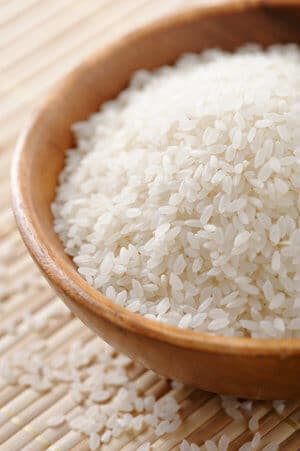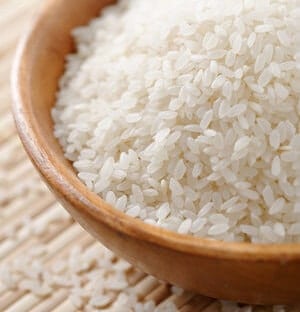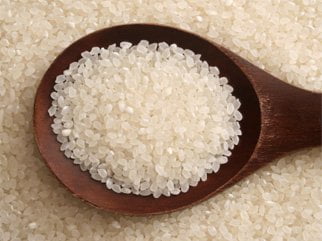How to make sushi rice – the complete recipe
Preparing sushi rice may seem complicated, but once you get started, you’ll find out that it is a bit like cooking ordinary rice, but with vinegar added to it, and a dash of Japanese technique. There are four key steps to making sushi rice: washing, soaking, cooking, and seasoning. Let’s review everything you need to know:
Choosing the right rice
Japanese short-grain rice has a higher starch content than long-grain rice and takes a different amount of water than long-grain rice. Short-grain rice is stickier and better for holding its shape when rolled into sushi. Long-grain (‘regular’) rice just isn’t sticky enough for sushi-making. Here is what a bag of sushi rice should look like.
Measuring sushi rice

Prepare 1 cup of sushi rice per 3 sushi rolls. Each roll makes up 6-8 little sushi pieces. 2 rolls are recommended per person, depending on personal preferences. Wash the rice (1 cup = 3 rolls) with running water for 1-2 minutes until there is no more starch coming out of it. For best results, let the rice soak in water for 30 minutes to help soften it.
After washing the rice, place it gently in a pot and add more water than rice. It should be about 1.2:1 in favor of the water. That is 20% more water compared to the rice. Do not add more water or you will end up with dough instead of rice.
Still not sure? Check out our Quantity Calculator.Cooking the rice
Cook the rice on high heat at first, stirring every minute or two until the water boils. Then, lower the heat to low and cover the pot. After 6-8 minutes, check the water level – if there is no more water, only bigger grains of rice in the pot, the rice is ready. If not, check back every minute, making sure not to burn the rice at the bottom.
Quantity calculator
We are here to help with all the calculations. Select how much you will be making, and the calculator will provide you with the quantities. Have a go!
Units:
Taking out the rice
When taking the rice out of the pot, only use a wooden spoon to handle the cooked rice. A metal spoon will cause the rice to be damaged, and it can also react with the vinegar that we will be adding later.
Second, do not scrape the rice out from the bottom of the pot. If it comes out easily, that is great. Otherwise, do not use it. The rice will taste bad. Put it in wooden or plastic bowls to chill.
Seasoning the rice

Rice vinegar mixed with sugar and salt is essential for giving sushi its distinct combination of flavors. If you neglect this part, your sushi won’t quite taste like sushi should. It is not recommended to substitute rice vinegar as most types of vinegar are much too strong. Rice vinegar is more delicate and blends in perfectly with the rice.
How to season the rice
- For 3 cups of dry sushi rice, use 0.5 cup of rice vinegar, 2 tablespoons of sugar, and 2 teaspoons of salt. Use only rice vinegar! Any other kind of vinegar will taste bad. Alternatively, you could use sushi rice seasoning powder.
- Mix together in a small pot on medium heat until all the solids are mixed together.
- Pour the mixture onto the rice and mix well. That should take a minute or two.
- Let the rice cool down for a few minutes until it reaches room temperature. Don’t put the rice in the fridge to make it cool faster – that will damage the rice. You can, however, use a fan, A/C, or put it by the window.
Important tip – Some people prefer less seasoned sushi rice. Also, the strength of rice vinegar can vary depending on the brand. If it is your first time making sushi rice, or you are uncertain, prepare half the amount of seasoning described above. Mix it with the rice and taste.
Trust your own palette if you want to use the full amount or not.
Final thoughts
That’s it, you’ve made it! For the sake of the internet, please take a moment to share your experience in the comments section below. Did it turn out as you expected? Better? Ask any questions you have, somebody will be able to answer, and it might even help other folks with the same question in the future. And most importantly, enjoy making sushi!





Hello, can you explain if the measurement of cup here refers to a regular cup or a rice cup? The cup came with the rice cooker is a smaller size cup and is what I use when I cook rice. Thanks.
I think that the ratio is what is essential here, rather than the actual volume. 3 cups dry rice to 1/2 cup vinegar, so long as you use the same measuring vessel. It’s 6:1.
I know this was forever ago. I was always told when using a cup for rice it doesnt matter the size (measuring compared to coffee cupnor other cup) as long as you use the same size cup for water too.
I just cooked some perfect rice. Thank you!!!
Hi I just would like to know the portions in Grams since I live in Europe.
Can anyone help me??
I would like to know for 5 sushi rolls
You can change the measurement to metrics
I have read through many times and can’t seem to find the cooking time for stovetop cooking?
Great job on this recipe. Informative and concise. Turns out perfect each and every time.
Took your suggestion of having my girlfriend assemble the rolls and nigiri as part if her birthday dinner surprise.
Great recipe!! Made quarantine a little more fun
Mirin
A staple ingredient that is commonly used in Japanese cuisine, mirin is a sweet rice liquor that is fermented with koji, which is used to make the alcoholic drinks saké and shochu. Approximately 400-500 years ago, a typical seasoning comprised a mixture of shochu and mirin. This mixer was commonly consumed as an alcoholic liquor or as a sweetener to make shochu more tolerable to drink.
Mirin is made by adding shochu, a distilled spirit from rice, halfway through the saké brewing process. The shochu stops the process by killing the fungus in the fermenting rice. Mirin is also made by using steamed glutinous rice, a sweet mochi rice, mixed with rice malt and distilled rice shochu. Interestingly, glutinous rice is, in fact, gluten-free. Shochu alcohol stops the malt function, decomposes the protein and starch found in glutinous rice, and stops the saké fermenting and becoming sweet and thick. In general, the addition of shochu gives mirin a light, sweet, and slightly malty taste, which makes it suitable for either drinking or cooking. Amazake Saké is also made in the same way; however, it is stored and cured for an additional 18 months.
When it comes to purchasing a good-quality mirin, much of the products sold in stores today are nothing like the original malted rice liquor. In fact, many Japanese companies based in the USA that produce mirin use corn syrup instead of the natural method of production, which is really a shame!
“Real” mirin should taste like a rice Liquor with a mildly sweet taste and can be enjoyed as a cocktail mixed with soda or even fruit juices. When used as a garnish or dressing, mirin has a savory flavor, a caramel color, and a glossy sheen.
Here, it should be noted that mirin is neither saké nor vinegar. Moreover, mirin should not be mistaken for sweetened rice wine. An authentic mirin should contain approximately 12-14% alcohol, and because of the way it ages, along with its sugar content, mirin has a golden to light-amber color and a slightly thick consistency. Please don’t let false labeling convince you that are buying a “real” mirin.
Mirin is also used to make sushi rice as it gives a mild sweetness and deeper flavor to the rice, as well as the velvety texture that makes sushi really special. Mirin is an essential ingredient in the Japanese culinary arts. If you are planning a special meal or dinner, make sure to buy high-quality ingredients. This is especially true for mirin and Japanese rice, which should always be high-quality.
Very interesting – Thanks for sharing! How do you know so much about mirin?
Thanks for the information …enjoyed that bit of reading
I have been using this recipe for years and it never disappoints 😊
This was my first attempt at making sushi rice, and it was perfect!
I tried the standard recipe with 3 cups sushi rice (in our rice cooker) to make 9 rolls of sushi. Pre-mixing the vinegar, sugar and salt was a very important step, in order to avoid overstiring the rice. I added an extra tbsp of sugar. Adding the vinegar mixture to the rice when it is still very hot helps a bunch. I’m also glad that we purchased the full-sized sheets of Nori in a big resealable bag.
I use rice clickers and it come out very nice, and the seasoning was great. Thanks
I’m still looking for the perfect sushi rice recipe. I’ll try your method and maybe experiment with different kinds of rice vinegar to see which gives me the best results. I’m excited to see how it comes out!
Perfect recipe, thank you!
With no rice vinegar, I’m faced with a dilemma. I have an Italian white wine vinegar, a generic apple cider vinegar, and a tarragon white wine vinegar from France (it’s incredibly subtle). I also have balsamic but I’m quite certain that would be problematic. Oddly, I’m really leaning toward the tarragon… Any thoughts or suggestions? Should I change the proportions?
Can u make sushi bowls with this rice too
I’m not good in math so can u convert 1 japanese cup of rice in grams and the other ingredients also I’m single so I don’t want to waste any rice thank u
Perfect! I’ve followed step by step your direction andit turned out as if I had been doing this for ages, so thank you for helping me out with my first sushi ever. Easy to follow, clear instruction and no surprises at the end,
Thank you for sharing this recipe! Easy and delicious!
La recette est bonne et facile javais un peut de saumon fumé dans le frigo et par hasard je me suis tenté a faire des sushis c’etait amusant et bon…Merci
Can you make sushi rice without putting sugar?
Yes, it will not taste exactly the same and the rice will be less sticky, but other than that it’s up to your liking.
Great rice. You can get away with cider vinegar as a substitute for rice vinegar.
My 10 year old is making his first attempt at a California Roll today. So far so good with the rice. Just not certain for how long to let the rice cool to reach “body temp”. We’ll just play it by feel for now and hope it pans out.
It would be a good idea to spare at least 20-30 minutes for the rice to cool down. You can use that time to prepare the rest of ingredients for your sushi dinner. It is hard to predict exactly how long it would take is that depends on rice quantity, room temperature, etc.
I made sushi for my family for the first time. This recipe is great. So easy to accomplish. Thanks
Thanks, glad you enjoyed it!
What size are the nori sheets?????
According to Wikipedia, a nori sheet is approximately 18 cm × 20 cm (7 in × 8 in) and 3 grams (0.11 oz) in weight.
First time I made sushi rice and I found this recipe and directions very good. The rice wasn’t restaurant perfect however I think after a few more tries and some minor adjustments for my stove and equipment I will perfect it. Thank you.
Practice makes perfect. Glad you are enjoying this.